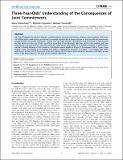Three-year-olds' understanding of the consequences of joint commitments
Abstract
Here we investigate the extent of children's understanding of the joint commitments inherent in joint activities. Three-year-old children either made a joint commitment to assemble a puzzle with a puppet partner, or else the child and puppet each assembled their own puzzle. Afterwards, children who had made the joint commitment were more likely to stop and wait for their partner on their way to fetch something, more likely to spontaneously help their partner when needed, and more likely to take over their partner's role when necessary. There was no clear difference in children's tendency to tattle on their partner's cheating behavior or their tendency to distribute rewards equally at the end. It thus appears that by 3 years of age making a joint commitment to act together with others is beginning to engender in children a "we"-intentionality which holds across at least most of the process of the joint activity until the shared goal is achieved, and which withstands at least some of the perturbations to the joint activity children experience.
Citation
Graefenhain , M , Carpenter , M & Tomasello , M 2013 , ' Three-year-olds' understanding of the consequences of joint commitments ' , PLoS One , vol. 8 , no. 9 , e73039 . https://doi.org/10.1371/journal.pone.0073039
Publication
PLoS One
Status
Peer reviewed
ISSN
1932-6203Type
Journal article
Description
No external funding has supported the current work.Collections
Items in the St Andrews Research Repository are protected by copyright, with all rights reserved, unless otherwise indicated.

